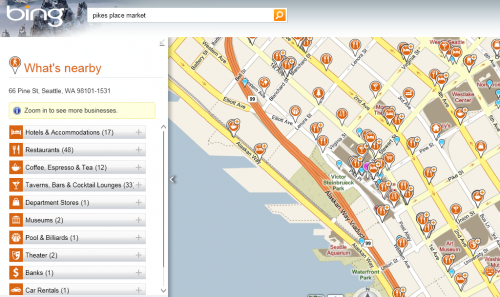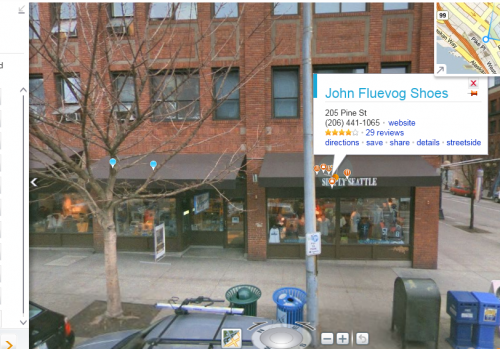Bing Maps Steals The Cool Crown From Google
Microsoft has had a collection of mapping tools and assets that haven’t been fully utilized or received the play (or usage) of Google Maps. But in an announcement today Bing Maps breaks new ground in online mapping even as it plays a bit of catch up with Google. First, Bing Maps is introducing “Street Side” […]
Microsoft has had a collection of mapping tools and assets that haven’t been fully utilized or received the play (or usage) of Google Maps. But in an announcement today Bing Maps breaks new ground in online mapping even as it plays a bit of catch up with Google.
First, Bing Maps is introducing “Street Side” in 56 US metro areas, with the ambition to go global eventually. This is the Microsoft answer to Google Street View: immersive street-level photography that, like Street View, allows users to “walk down the street” and explore neighborhoods in cities. Microsoft began Street Side at roughly the same time as Street View but hadn’t released anything (to date) other than this limited demo site.
The environment that Microsoft has created is richer than Street View and brings “augmented reality” into Maps in a compelling way. Microsoft has also utilized its 3D mapping assets in creating the new experience. Here’s how the Microsoft press material describes the technology behind the new Maps experience:
Photosynth and Silverlight are the underlying technologies in Bing Maps that connect everything and help provide the more seamless experience. Based on Seadragon and Photo Tourism concepts, Photosynth lets us literally “stitch” together photographs to provide more realistic view of locations as they appear in real life. Photosynth-enabled Streetside imagery is built on geometric models that are reconstructed underneath the imagery to provide a truly 3D experience that shows locations as they are in real life.
The one “catch” is that you need to install Microsoft Silverlight to make it all work. But once installed the new Bing Maps beta site enables a wide range of experiences, search and discovery tools that haven’t been available (or maybe possible) previously.
In addition there’s an “apps gallery” that enable data overlays directly on the map. All of the current modules are Microsoft created but the company will enable third parties to integrate their content into Bing Maps (e.g., Yelp reviews) in the near term.
Indeed, Twitter content tied to location is also available in the new Bing Maps. Here are some screens that illustrate the user experience:
Panning, zooming and moving between street-level map views and overhead angles was mostly very smooth for me, although there were a few glitches (perhaps because I’m on a Mac).
I asked whether this would come to mobile — the new Bing Mobile client is being announced today too — and the answer is that eventually Microsoft would like to bring this experience to mobile devices. But for now, with the new Bing Maps beta, what Microsoft has created is probably richest mapping and local search/discovery experience on the PC.
Postscript: There’s more discussion on the Bing Community Blog of the new Bing Maps upgrades, the mobile client and the Bing toolbar.
Contributing authors are invited to create content for Search Engine Land and are chosen for their expertise and contribution to the search community. Our contributors work under the oversight of the editorial staff and contributions are checked for quality and relevance to our readers. The opinions they express are their own.
Related stories
New on Search Engine Land




